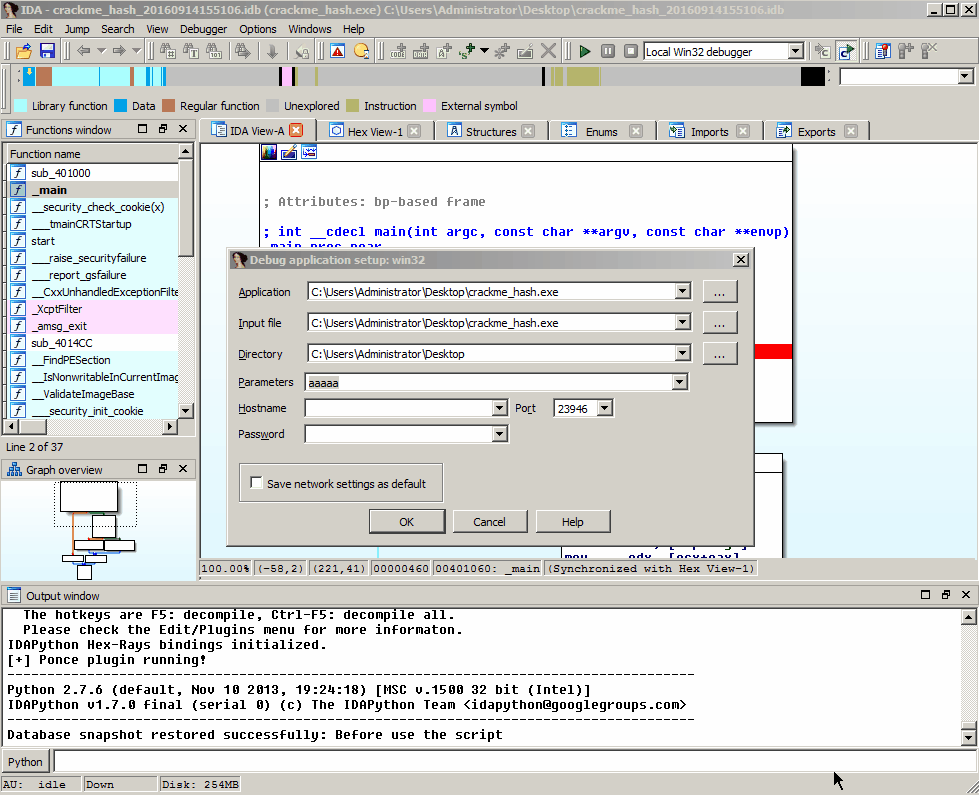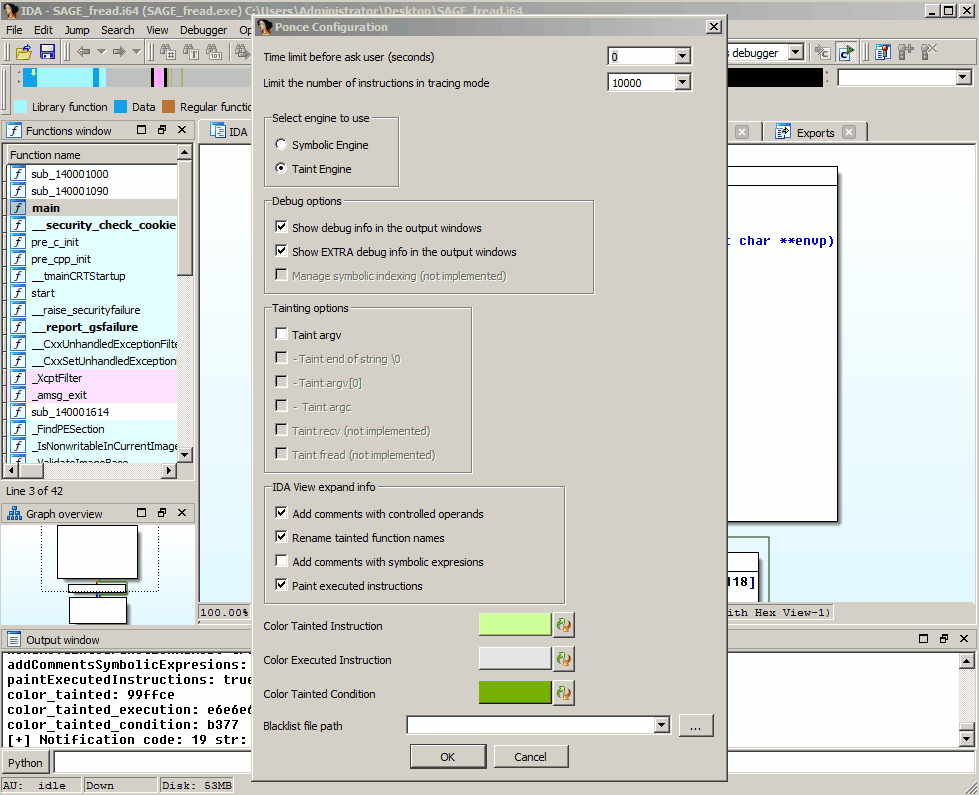Ponce is an IDA Pro plugin that provides users the ability to perform taint analysis and symbolic execution over binaries in an easy and intuitive fashion. With Ponce you are one click away from getting all the power from cutting edge symbolic execution. Entirely written in C/C++.
Symbolic execution is not a new concept in the security community. It has been around for years but it is not until the last couple of years that open source projects like Triton and Angr have been created to address this need. Despite the availability of these projects, end users are often left to implement specific use cases themselves.
We addressed these needs by creating Ponce, an IDA plugin that implements symbolic execution and taint analysis within the most used disassembler/debugger for reverse engineers.
Installation
Ponce works with both x86 and x64 binaries in IDA 6.8 and IDA 6.9x. Installing the plugin is as simple as copying the appropiate files from the latest builds to the plugins\ folder in your IDA installation directory.
Ponce has initial support of IDA 7.0 for both x86 and x64 binaries in Windows. The plugin named Ponce64.dll should be copied from the latest_builds to the plugins\ folder in your IDA installation directory. Starting from version 7.0, IDA64 should be used to work with both x86 and x64 binaries.
Don’t forget to register Ponce in plugins.cfg located in the same folder by adding the following line:
Ponce Ponce Ctrl+Shift+Z 0 WIN
Ponce works on Windows, Linux and OSX natively!
- Exploit development: Ponce can help you create an exploit in a far more efficient manner as the exploit developer may easily see what parts of memory and which registers you control, as well as possible addresses which can be leveraged as ROP gadgets.
- Malware Analysis: Another use of Ponce is related to malware code. Analyzing the commands a particular family of malware supports is easily determined by symbolizing a simple known command and negating all the conditions where the command is being checked.
- Protocol Reversing: One of the most interesting Ponce uses is the possibility of recognizing required magic numbers, headers or even entire protocols for controlled user input. For instance, Ponce can help you to list all the accepted arguments for a given command line binary or extract the file format required for a specific file parser.
- CTF: Ponce speeds up the process of reverse engineer binaries during CTFs. As Ponce is totally integrated into IDA you don’t need to worry about setup timing. It’s ready to be used!
The plugin will automatically run, guiding you through the initial configuration the first time it is run. The configuration will be saved to a configuration file so you won’t have to worry about the config window again.
Also Read – Tourmaline : Telegram Bot Framework For Crystal
- Tainting engine: This engine is used to determine at every step of the binary’s execution which parts of memory and registers are controllable by the user input.
- Symbolic engine: This engine maintains a symbolic state of registers and part of memory at each step in a binary’s execution path.
Use Symbolic Execution To Solve A CrackMe
Here we can see the use of the symbolic engine and how we can solve constrains:
- Passing simple
aaaaaas argument. - We first select the symbolic engine.
- We convert to symbolic the memory pointed by argv[1] (
aaaaa) - Identify the symbolic condition that make us win and solve it.
- Test the solution.

Negate and inject a condition
In the next gif we can see the use of automatic tainting and how we can negate a condition and inject it in memory while debugging:
- We select the symbolic engine and set the option to symbolize
argv. - We identify the condition that needs to be satisfied to win the crackMe.
- We negate an inject the solution everytime a byte of our input is checked against the key.
- Finally we get the key
elitethat has been injected in memory and therefore reach theWincode.

Using the tainting engine to track user controlled input
In this example we can see the use of the tainting engine with cmake. We are:
- Passing a file as argument to cmake to have him parsing it.
- We select we want to use the tainting engine
- We taint the buffer that “`fread()““ reads from the file.
- We resume the execution under the debugger control to see where the taint input is moved to.
- Ponce will rename the tainted functions. These are the functions that somehow the user has influence on, not the simply executed functions.

Use Negate, Inject & Restore
In the next example we are using the snapshot engine:
- Passing a file as argument.
- We select we want to use the symbolic engine.
- We taint the buffer that “`fread()““ reads from the file.
- We create a snapshot in the function that parses the buffer read from the file.
- When a condition is evaluated we negate it, inject the solution in memory and restore the snapshot with it.
- The solution will be “valid” so we will satisfy the existent conditions.

Usage
In this section we will list the different Ponce options as well as keyboard shortcuts:
- Access the configuration and taint/symbolic windows: Edit > Ponce > Show Config (Ctl+Shift+P and Ctl+Alt+T)

- Enable/Disable Ponce tracing (Ctl+Shift+E)

- Symbolize/taint a register (Ctl+Shift+R)

- Symbolize/taint memory. Can be done from the IDA View or the Hex View (Ctl+Shift+M)

- Solve formula (Ctl+Shift+S)

- Negate & Inject (Ctl+Shift+N)

- Negate, Inject & Restore Snaphot (Ctl+Shift+I)

- Create Execution Snapshot (Ctl+Shift+C)

- Restore Execution Snapshot (Ctl+Shift+S)

- Delete Execution Snapshot (Ctl+Shift+D)

- Execute Native (Ctl+Shift+F9)

Building
We provide compiled binaries for Ponce, but if you want to build your own plugin you can do so using Visual Studio 2013. We tried to make the building process as easy as possible:
- Clone the project with submodules:
git clone –recursive https://github.com/illera88/PonceProject.git
- Open
Build\PonceBuild\Ponce.sln: The project configuration is ready to use the includes and libraries shipped with the project that reside inexternal-libs\. - The VS project has a
Post-Build Eventthat will move the created binary plugin to the IDA plugin folder for you.copy /Y $(TargetPath) "C:\Program Files (x86)\IDA 6.9\plugins".
NOTE: use your IDA installation path.
The project has 4 build configurations:
- x86ReleaseStatic: will create the 32 bits version statically linking every third party library into a whole large plugin file.
- x86ReleaseZ3dyn: will create the 32 bits version statically linking every third party library but z3.lib.
- x64ReleaseStatic: will create the 64 bits version statically linking every third party library into a whole large plugin file.
- x64ReleaseZ3dyn: will create the 64 bits version statically linking every third party library but z3.lib.
The static version of z3.lib is ~ 1.1Gb and the linking time is considerable. That’s the main reason why we have a building version that uses z3 dynamically (as a dll). If you are using z3 dynamically don’t forget to copy the libz3.dll file into the IDA’s directory.
Credit: Alberto Garcia Illera & Francisco Oca















.png)
